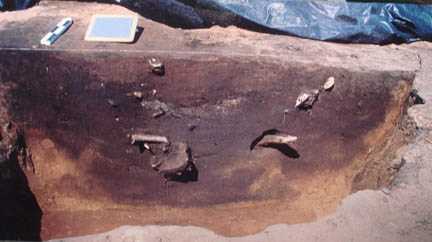Archaeology Terms
Storage Pits
 Storage Pit Archaeologists think that many of the features found at archaeological sites were originally dug to serve as storage pits for agricultural crops (corn, beans, squash – all of which can often be recovered during flotation in light fraction samples). The structure of the pit may well have been similar to that described by an Hidatsa Indian, Buffalo Bird Woman to anthropologist Gilbert Wilson, who published Buffalo Bird Woman’s Garden in 1917 (http://digital.library.upenn.edu/women/buffalo/garden/garden.html). The pit should be lined with grasses to keep the crops from becoming moldy from contact with the soil. The outer layer consisted of chains of corncobs, with shelled corn inside, as well as slices of dried squash. A drawing of Buffalo Bird Woman’s storage pit can be seen at: http://digital.library.upenn.edu/women/buffalo/garden/garden.html#VII. Archaeologists rarely find actual storage features as they were reused as refuse pits.
Storage Pit Archaeologists think that many of the features found at archaeological sites were originally dug to serve as storage pits for agricultural crops (corn, beans, squash – all of which can often be recovered during flotation in light fraction samples). The structure of the pit may well have been similar to that described by an Hidatsa Indian, Buffalo Bird Woman to anthropologist Gilbert Wilson, who published Buffalo Bird Woman’s Garden in 1917 (http://digital.library.upenn.edu/women/buffalo/garden/garden.html). The pit should be lined with grasses to keep the crops from becoming moldy from contact with the soil. The outer layer consisted of chains of corncobs, with shelled corn inside, as well as slices of dried squash. A drawing of Buffalo Bird Woman’s storage pit can be seen at: http://digital.library.upenn.edu/women/buffalo/garden/garden.html#VII. Archaeologists rarely find actual storage features as they were reused as refuse pits.

